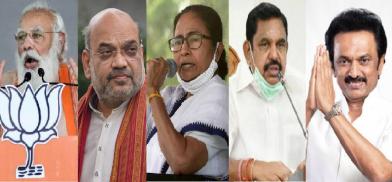Is the tide running out for Modi?
But for the waning of his appeal, it is difficult to explain why the BJP came a cropper in West Bengal even after the enormous effort which both Modi and his powerful Home Minister Amit Shah put into their campaigns in the state with scores of public rallies and roadshows, writes Amulya Ganguli for South Asia Monitor

What the Bharatiya Janata Party's (BJP) defeat in three of the four states which went to the polls along with a Union territory shows is that Prime Minister Narendra Modi’s magic, which led his party to a spectacular victory in the 2019 parliamentary polls, may have begun to fade.
But for the waning of his appeal, it is difficult to explain why the BJP came a cropper in West Bengal even after the enormous effort which both Modi and his powerful Home Minister Amit Shah put into their campaigns in the state with scores of public rallies and roadshows.
There is no denying that these drew large and enthusiastic crowds which responded raucously to the prime minister’s “Didi-o-Didi” jibes, although these were compared by Trinamool Congress MP Mahua Maitra to the catcalls of roadside Romeos in the West Bengal towns.
Amit Shah’s rallies, too, were well attended, suggesting that the improvement in the BJP’s position in 2019, when the party raised its vote share from 18 per cent in 2014 to 40, had not been dissipated.
Drop in BJP vote share
But the May 2 results underlined the ephemeral nature of these gains. Evidently, nether Modi’s rhetorical flourishes, nor Amit Shah’s energetic chanting of “Jai Shri Ram”, which Mamata Banerjee had once described as the BJP’s war cry, has enabled the BJP to push ahead. Its vote share has now dropped to 38 per cent.
Arguably, it would have dropped even further if the elections had not been held towards the fag end of the disastrous second wave of Covid-19. As a result, the BJP escaped being pilloried for the gross mismanagement of the measures for controlling the pandemic. Even then, the drubbing which it has received in terms of winning seats underlines a deep unease bordering on a visceral dislike for the BJP outside its core base of anti-Muslim Hindus.
If some of the posts in social media are an indication, the BJP has held on to this vote bank notwithstanding the buffeting which these communal groups have received from the outpouring of support for Mamata Banerjee. At the root of this support is her fiery image as a street fighter – a term which she has used for herself – who has now begun to be associated with the preservation of Bengal’s “asmita” or pride – an attribute which Modi highlighted in Gujarat when he was fending off charges of complicity in the 2002 riots.
Ironically, Mamata’s combative image may have been enhanced by her accident which forced her to campaign in a wheelchair. If anything, this display of her determination to carry on whatever the odds highlighted her never-say-die attitude.
Factors such as these apparently helped Mamata to erase the stains on her record left by the lawlessness of the Trinamool cadres during the 2018 local body elections, their recourse to strong-arm tactics to put pressure on realtors In what came to be known as the “cut money” phenomenon and the alleged mishandling of the cyclone relief materials last year.
Mamata's extraordinary feat
What also helped Mamata to come out on top is the ignominious collapse of a third front comprising the Left, the Congress and the outfit of a small-time Muslim cleric. Any fear that the latter will split the Muslim vote to the BJP’s advantage has been belied. Evidently, the minorities knew who their friends are and who their foes.
Among the latter can be counted the BJP’s winner in Nandigram, Suvendu Adhikari, who must be pleased for having defeated “Begum” Mamata, as he dubbed her in a characteristically saffron polarizing ploy. But the overall outcome has shown that he has backed the wrong horse.
The irony is that in all likelihood, Mamata Banerjee may well become the fulcrum of a national opposition to the BJP. For many, it is a position which Mamata Banerjee deserves more than any other non-BJP leader because of her extraordinary feat of routing the seemingly invincible Modi-Shah juggernaut, which is believed to be backed by enormous resources and clandestine institutional manipulation.
No other leader has been able to accomplish what "Begum" DIdi has done – neither the DMK’s M.K. Stalin in Tamil Nadu, nor the CPI(M)’s Pinarayi Vijayan in Kerala - if only because the BJP is not a force to reckon with in their states. Even then, their victories represent a plus factor for federalism which has been under a severe strain from the BJP’s centralizing tendencies.
As powerful regional satraps, they are bound to be a part of a national coalition with parties like the Trinamool Congress, the Congress (weak as it is), the Nationalist Congress Party, the Shiv Sena, the Rashtriya Janata Dal, the Samajwadi Party and the Aam Admi Party. On paper, it is a formidable line-up, but no one can say whether it will be able to withstand the internal strains caused by egos and ideological confusion.
As for the BJP, it has had the consolation prizes of success in a small state – Assam – and a small Union territory – Puducherry. But it has to be remembered that the elections in these two areas were held before the reports about the lack of hospital beds, oxygen and vaccines roiled the nation. How the people would have voted if the polls were held there later cannot be said for certain.
(The author is a writer on current affairs. Views are personal)









Post a Comment